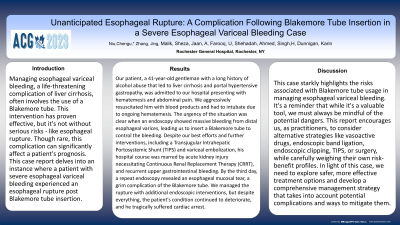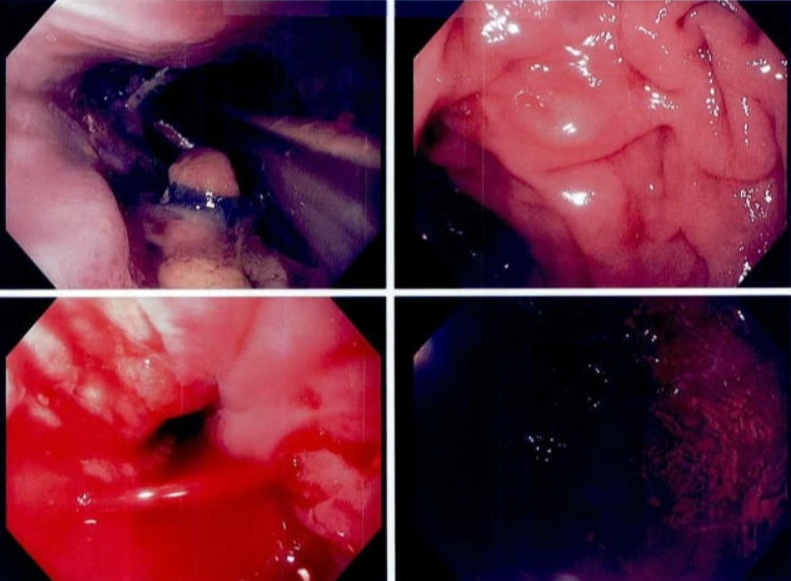Monday Poster Session
Category: Esophagus
P1894 - Unanticipated Esophageal Rupture: A Complication Following Blakemore Tube Insertion in a Severe Esophageal Variceal Bleeding Case
Monday, October 23, 2023
10:30 AM - 4:15 PM PT
Location: Exhibit Hall

Has Audio
- CN
Chengu Niu, MD
Rochester General Hospital
Rochester, NY
Presenting Author(s)
Chengu Niu, MD1, Tausif Syed, MD1, Ali Jaan, MD1, Sheza Malik, MD1, Umer Farooq, MD1, Ahmed Shehadah, MD1, Harkarandeep Singh, MD1, Jay Bapaye, MD1, Hemanth Boppana, MD2, Jing Zhang, MD3, Karin Dunnigan, MD1
1Rochester General Hospital, Rochester, NY; 2Rochester General hospital, Rochester, NY; 3Rainier Springs Hospital, Vancouver, WA
Introduction: Managing esophageal variceal bleeding, a life-threatening complication of liver cirrhosis, often involves the use of a Blakemore tube. This intervention has proven effective, but it's not without serious risks - like esophageal rupture. Though rare, this complication can significantly affect a patient's prognosis. This case report delves into an instance where a patient with severe esophageal variceal bleeding experienced an esophageal rupture post Blakemore tube insertion.
Case Description/Methods: Our patient, a 41-year-old gentleman with a long history of alcohol abuse that led to liver cirrhosis and portal hypertensive gastropathy, was admitted to our hospital presenting with hematemesis and abdominal pain. We aggressively resuscitated him with blood products and had to intubate due to ongoing hematemesis. The urgency of the situation was clear when an endoscopy showed massive bleeding from distal esophageal varices, leading us to insert a Blakemore tube to control the bleeding. Despite our best efforts and further interventions, including a Transjugular Intrahepatic Portosystemic Shunt and variceal embolization, his hospital course was marred by acute kidney injury necessitating Continuous Renal Replacement Therapy, and recurrent upper gastrointestinal bleeding. By the third day, a repeat endoscopy revealed an esophageal tear, a grim complication of the Blakemore tube. We managed the rupture with additional endoscopic interventions, but despite everything, the patient's condition continued to deteriorate, and he tragically suffered cardiac arrest.
Discussion: This case starkly highlights the risks associated with Blakemore tube usage in managing esophageal variceal bleeding. It's a reminder that while it's a valuable tool, we must always be mindful of the potential dangers. This report encourages us, as practitioners, to consider alternative strategies like vasoactive drugs, endoscopic band ligation, endoscopic clipping, TIPS, or surgery, while carefully weighing their own risk-benefit profiles. In light of this case, we need to explore safer, more effective treatment options and develop a comprehensive management strategy that takes into account potential complications and ways to mitigate them.

Disclosures:
Chengu Niu, MD1, Tausif Syed, MD1, Ali Jaan, MD1, Sheza Malik, MD1, Umer Farooq, MD1, Ahmed Shehadah, MD1, Harkarandeep Singh, MD1, Jay Bapaye, MD1, Hemanth Boppana, MD2, Jing Zhang, MD3, Karin Dunnigan, MD1. P1894 - Unanticipated Esophageal Rupture: A Complication Following Blakemore Tube Insertion in a Severe Esophageal Variceal Bleeding Case, ACG 2023 Annual Scientific Meeting Abstracts. Vancouver, BC, Canada: American College of Gastroenterology.
1Rochester General Hospital, Rochester, NY; 2Rochester General hospital, Rochester, NY; 3Rainier Springs Hospital, Vancouver, WA
Introduction: Managing esophageal variceal bleeding, a life-threatening complication of liver cirrhosis, often involves the use of a Blakemore tube. This intervention has proven effective, but it's not without serious risks - like esophageal rupture. Though rare, this complication can significantly affect a patient's prognosis. This case report delves into an instance where a patient with severe esophageal variceal bleeding experienced an esophageal rupture post Blakemore tube insertion.
Case Description/Methods: Our patient, a 41-year-old gentleman with a long history of alcohol abuse that led to liver cirrhosis and portal hypertensive gastropathy, was admitted to our hospital presenting with hematemesis and abdominal pain. We aggressively resuscitated him with blood products and had to intubate due to ongoing hematemesis. The urgency of the situation was clear when an endoscopy showed massive bleeding from distal esophageal varices, leading us to insert a Blakemore tube to control the bleeding. Despite our best efforts and further interventions, including a Transjugular Intrahepatic Portosystemic Shunt and variceal embolization, his hospital course was marred by acute kidney injury necessitating Continuous Renal Replacement Therapy, and recurrent upper gastrointestinal bleeding. By the third day, a repeat endoscopy revealed an esophageal tear, a grim complication of the Blakemore tube. We managed the rupture with additional endoscopic interventions, but despite everything, the patient's condition continued to deteriorate, and he tragically suffered cardiac arrest.
Discussion: This case starkly highlights the risks associated with Blakemore tube usage in managing esophageal variceal bleeding. It's a reminder that while it's a valuable tool, we must always be mindful of the potential dangers. This report encourages us, as practitioners, to consider alternative strategies like vasoactive drugs, endoscopic band ligation, endoscopic clipping, TIPS, or surgery, while carefully weighing their own risk-benefit profiles. In light of this case, we need to explore safer, more effective treatment options and develop a comprehensive management strategy that takes into account potential complications and ways to mitigate them.

Figure: Brisk bleeding in distal esophagus
Disclosures:
Chengu Niu indicated no relevant financial relationships.
Tausif Syed indicated no relevant financial relationships.
Ali Jaan indicated no relevant financial relationships.
Sheza Malik indicated no relevant financial relationships.
Umer Farooq indicated no relevant financial relationships.
Ahmed Shehadah indicated no relevant financial relationships.
Harkarandeep Singh indicated no relevant financial relationships.
Jay Bapaye indicated no relevant financial relationships.
Hemanth Boppana indicated no relevant financial relationships.
Jing Zhang indicated no relevant financial relationships.
Karin Dunnigan indicated no relevant financial relationships.
Chengu Niu, MD1, Tausif Syed, MD1, Ali Jaan, MD1, Sheza Malik, MD1, Umer Farooq, MD1, Ahmed Shehadah, MD1, Harkarandeep Singh, MD1, Jay Bapaye, MD1, Hemanth Boppana, MD2, Jing Zhang, MD3, Karin Dunnigan, MD1. P1894 - Unanticipated Esophageal Rupture: A Complication Following Blakemore Tube Insertion in a Severe Esophageal Variceal Bleeding Case, ACG 2023 Annual Scientific Meeting Abstracts. Vancouver, BC, Canada: American College of Gastroenterology.
